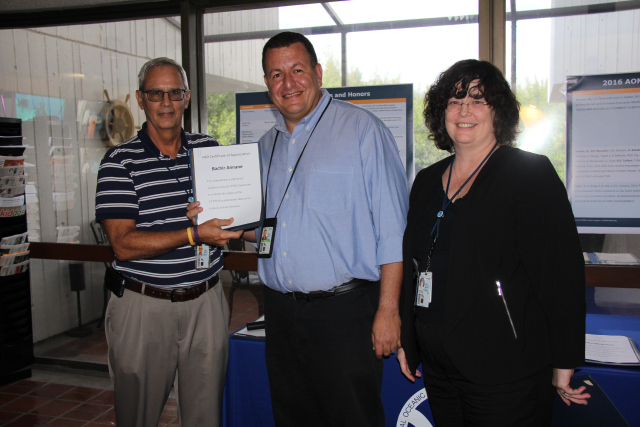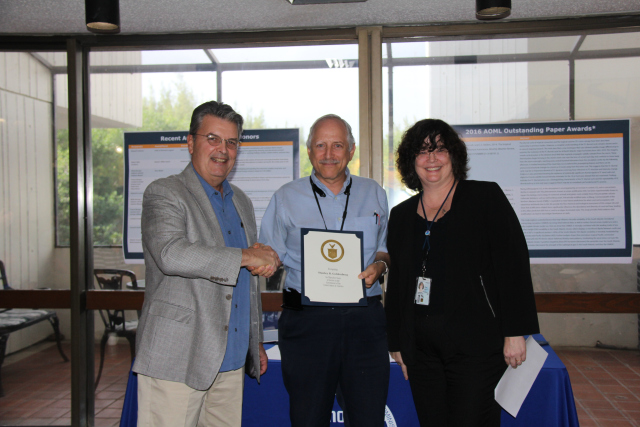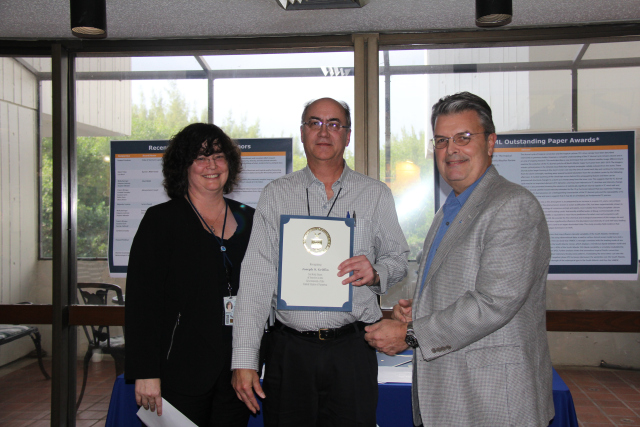At a recent awards ceremony, HRD Director Frank Marks and AOML Deputy Director Molly Beringer presented recognitions to several employees whose service went above-and-beyond during the past year.
Bachir Annane was recognized for comprehensive and timely analyses using the OSSE framework to evaluate the impact of the CYGNSS scatterometer data set on tropical cyclone forecasts.

Jun Zhang, Kelly Ryan, and Lisa Bucci (not in photo) for successfully operating and executing the Doppler Wind Lidar instrument on NOAA’s P3 Hurricane Hunter aircraft during the 2015 and 2016 IFEX hurricane field programs.

Shirley Murillo for excellence in leading the Hurricane Research Division’s Observing System Simulation Experiment science research group.

Stanley Goldenberg was recognized for 35 years of federal service. Never one to shy from comment, Stan is one of the most public faces of hurricane research at AOML, communicating hurricane science and the message of preparedness to thousands each year. Stan’s focus on hurricane climatology produced a widely referenced 2001 Science publication describing a multidecadal pattern in Atlantic hurricane activity, and he is a member of NOAA’s seasonal hurricane outlook team. In recent years, Stan has found his niche in supporting the HWRF modeling group in the Hurricane Research Division. Stan helps evaluate model output to help ensure the model gets it right for the right reasons, applying his experience as a veteran hurricane scientist. Thank you for your service Stan!

Joe Griffin was recognized for 40 years of federal service. Joe is a computer specialist with the Hurricane Research Division. He wrote all the code underpinning the software to process our aircraft data sets from the radar data sets to the dropsondes, including developing the original airborne work station allowing the real-time processing of radar data and transmission of radar analyses to NHC. Since 2003 he has been HRD’s chief information officer supporting all of the division’s computing needs, ensuring access to all of the aircraft data sets to hurricane researchers across the world. As HRD’s computing needs evolved with the addition of modeling and OSSEs, he has expanded his efforts to maintaining the servers that support these groups, procuring and administering a small high-performance computing system, Ooyama 1&2. Thank you for your service Joe!
In addition, Sonia Otero was recognized for software engineering leadership during the development of the Airborne Atmospheric Measurement and Profiling System (AAMPS), the principal aircraft data system used on the NOAA WP-3D and Gulfstream-IV Hurricane Hunter aircraft from 2007-2016.
Jason Dunion was awarded the AOML Best Paper Award for his paper on the tropical cyclone diurnal cycle: Dunion, J.P., C.D. Thorncraft, and C.S. Velden, 2015: The tropical cyclone diurnal cycle of mature hurricanes. Monthly Weather Review, 142(10):3900-3919 (doi:10.1175/MWR-D-00191-1).
Congratulations to all the award winners!

























